Examples of Setting Up Consumable Resources
Use the following examples to guide you in setting up consumable resources for your site.
Example 1: Floating Software License Management
Suppose you are using the software package pam-crash in your cluster, and you have access to 10 floating licenses. You can use pam-crash on every system as long as no more than 10 invocations of the software are active. The goal is to configure the grid engine system in a way that prevents scheduling pam-crash jobs while all 10 licenses are occupied by other running pam-crash jobs.
With consumable resources, you can achieve this goal easily. First you must add the number of available pam-crash licenses as a global consumable resource to the complex configuration.
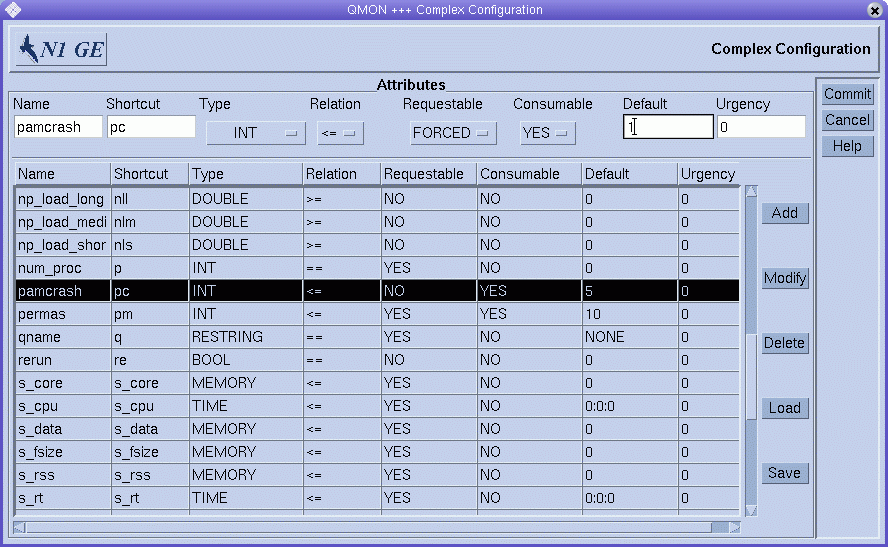
The name of the consumable attribute is set to pam-crash. You can use pc as a shortcut in the qalter -l, qselect -l, qsh -l, qstat -l, or qsub -l commands instead.
The attribute type is defined to be an integer counter.
The Requestable flag is set to FORCED. This setting specifies that users must request how many pam-crash licenses that their job will occupy when the job is submitted.
The Consumable flag specifies that the attribute is a consumable resource.
The setting Default is irrelevant since Requestable is set to FORCED, which means that a request value must be received for this attribute with any job.
Consumables receive their value from the global, host, or queue configurations through the complex_values lists. See the host_conf(5) and queue_conf(5) man pages, as well as Configuring Queues and Configuring Hosts.
To activate resource planning for this attribute and for the cluster, the number of available pam-crash licenses must be defined in the global host configuration.

The value for the attribute pam-crash is set to 10, corresponding to 10 floating licenses.
Note –
The table Consumables/Fixed Attributes corresponds to the complex_values entry that is described in the host configuration file format host_conf(5).
Assume that a user submits the following job:
% qsub -l pc=1 pam-crash.sh |
The job starts only if fewer than 10 pam-crash licenses are currently occupied. The job can run anywhere in the cluster, however, and the job occupies one pam-crash license throughout its run time.
One of your hosts in the cluster might not be able to be included in the floating license. For example, you might not have pam-crash binaries for that host. In such a case, you can exclude the host from the pam-crash license management. You can exclude the host by setting to zero the capacity that is related to that host for the consumable attribute pam-crash. Use the Execution Host tab of the Host Configuration dialog box.
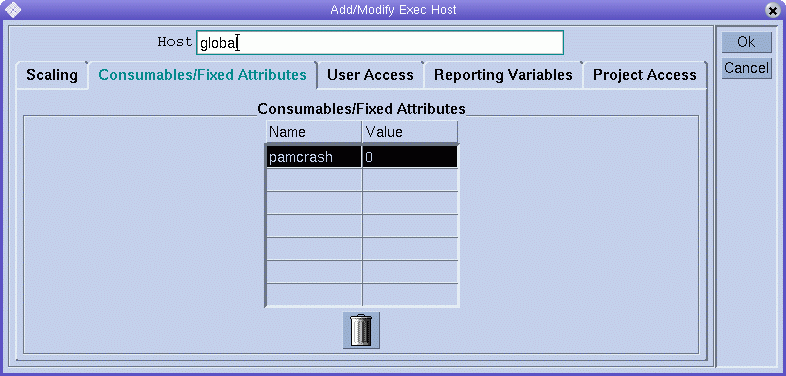
Note –
The pam-crash attribute is implicitly available to the execution host because the global attributes of the complex are inherited by all execution hosts. By setting the capacity to zero, you could also restrict the number of licenses that a host can manage to a nonzero value such as two. In this case, a maximum of two pam-crash jobs could coexist on that host.
Similarly, you might want to prevent a certain queue from running pam-crash jobs. For example, the queue might be an express queue with memory and CPU-time limits not suitable for pam-crash. In this case, set the corresponding capacity to zero in the queue configuration, as shown in the following figure.
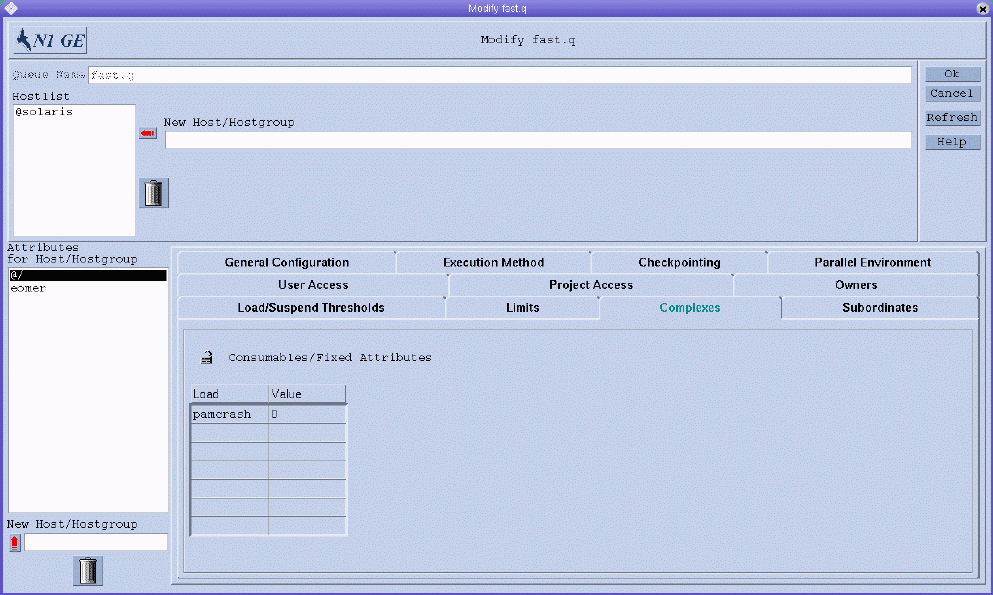
Note –
The pam-crash attribute is implicitly available to the queue because the global attributes of the complex are inherited by all queues.
Example 2: Space Sharing for Virtual Memory
Administrators must often tune a system to avoid performance degradation caused by memory oversubscription, and consequently swapping of a machine. The grid engine software can support you in this task through the Consumable Resources facility.
The standard load parameter virtual_free reports the available free virtual memory, that is, the combination of available swap space and the available physical memory. To avoid swapping, the use of swap space must be minimized. In an ideal case, all the memory required by all processes running on a host should fit into physical memory.
The grid engine software can guarantee the availability of required memory for all jobs started through the grid engine system, given the following assumptions and configurations:
-
virtual_free is configured as a consumable resource, and its capacity on each host is set to the available physical memory, or lower.
-
Jobs request their anticipated memory usage, and the value that jobs request is not exceeded during run time.
An example of a possible virtual_free resource definition is shown in Figure 3–2. A corresponding execution host configuration for a host with 1 Gbyte of main memory is shown in Figure 3–3.
In the virtual_free resource definition example, the Requestable flag is set to YES instead of to FORCED, as in the example of a global configuration. This means that users need not indicate the memory requirements of their jobs. The value in the Default field is used if an explicit memory request is missing. The value of 1 Gbyte as default request in this case means that a job without a request is assumed to occupy all available physical memory.
Note –
virtual_free is one of the standard load parameters of the grid engine system. The additional availability of recent memory statistics is taken into account automatically by the system in the virtual memory capacity planning. If the load report for free virtual memory falls below the value obtained by grid engine software internal bookkeeping, the load value is used to avoid memory oversubscription. Differences in the reported load values and the internal bookkeeping can occur easily if jobs are started without using the grid engine system.
If you run different job classes with different memory requirements on one machine, you might want to partition the memory that these job classes use. This functionality is called space sharing. You can accomplish this functionality by configuring a queue for each job class. Then you assign to each queue a portion of the total memory on that host.
In the example, the queue configuration attaches half of the total memory that is available to host carc to the queue fast.q for the host carc. Hence the accumulated memory consumption of all jobs that are running in queue fast.q on host carc cannot exceed 500 Mbytes. Jobs in other queues are not taken into account. Nonetheless, the total memory consumption of all running jobs on host carc cannot exceed 1 Gbyte.
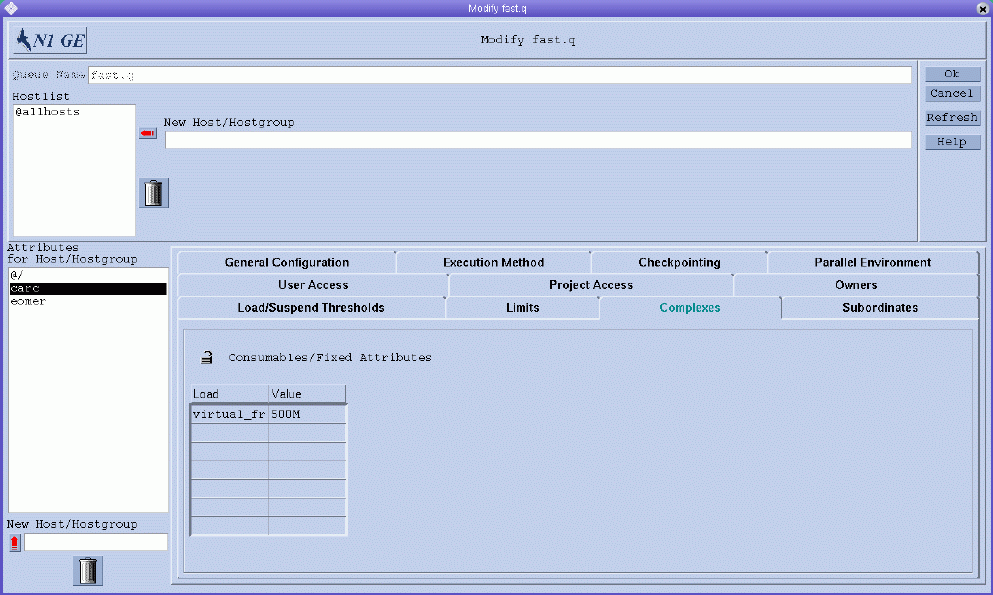
Note –
The attribute virtual_free is available to all queues through inheritance from the complex.
Users might submit jobs to a system configured similarly to the example in either of the following forms:
% qsub -l vf=100M honest.sh % qsub dont_care.sh |
The job submitted by the first command can be started as soon as at least 100 Mbytes of memory are available. This amount is taken into account in the capacity planning for the virtual_free consumable resource. The second job runs only if no other job is on the system, as the second job implicitly requests all the available memory. In addition, the second job cannot run in queue fast.q because the job exceeds the queue's memory capacity.
Example 3: Managing Available Disk Space
Some applications need to manipulate huge data sets stored in files. Such applications therefore depend on the availability of sufficient disk space throughout their run time. This requirement is similar to the space sharing of available memory, as discussed in the preceding example. The main difference is that the grid engine system does not provide free disk space as one of its standard load parameters. Free disk space is not a standard load parameter because disks are usually partitioned into file systems in a site-specific way. Site-specific partitioning does not allow identifying the file system of interest automatically.
Nevertheless, available disk space can be managed efficiently by the system through the consumables resources facility. You should use the host resource attribute h_fsize for this purpose.
First, the attribute must be configured as a consumable resource, as shown in the following figure.
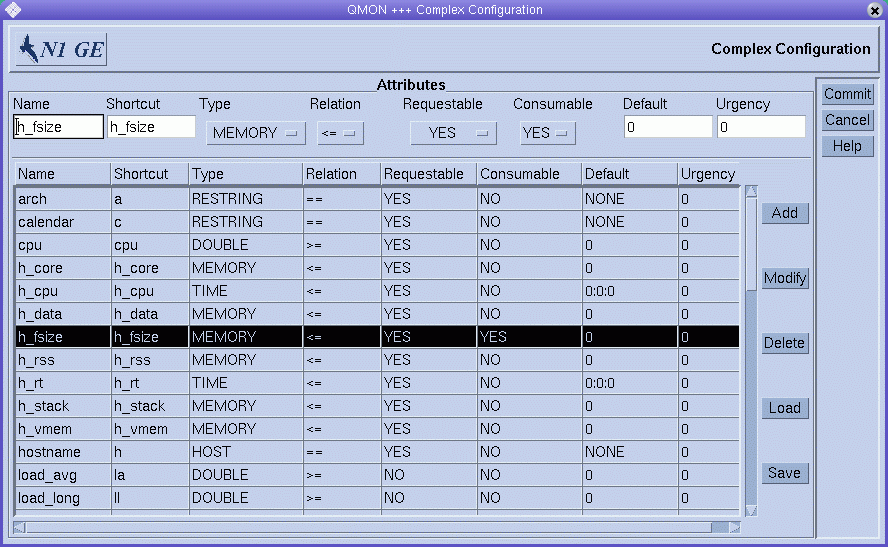
In the case of local host file systems, a reasonable capacity definition for the disk space consumable can be put in the host configuration, as shown in the following figure.

Submission of jobs to a grid engine system that is configured as described here works similarly to the previous examples:
% qsub -l hf=5G big-sort.sh |
The reason the h_fsize attribute is recommended here is that h_fsize also is used as the hard file size limit in the queue configuration. The file size limit restricts the ability of jobs to create files that are larger than what is specified during job submission. The qsub command in this example specifies a file size limit of 5 Gbytes. If the job does not request the attribute, the corresponding value from the queue configuration or host configuration is used. If the Requestable flag for h_fsize is set to FORCED in the example, a request must be included in the qsub command. If the Requestable flag is not set, a request is optional in the qsub command.
By using the queue limit as the consumable resource, you control requests that the user specifies instead of the real resource consumption by the job scripts. Any violation of the limit is sanctioned, which eventually aborts the job. The queue limit ensures that the resource requests on which the grid engine system internal capacity planning is based are reliable. See the queue_conf(5) and the setrlimit(2) man pages for details.
Note –
Some operating systems provide only per-process file size limits. In this case, a job might create multiple files with a size up to the limit. On systems that support per-job file size limitation, the grid engine system uses this functionality with the h_fsize attribute. See the queue_conf(5) man page for further details.
You might want applications that are not submitted to the grid engine system to occupy disk space concurrently. If so, the internal bookkeeping might not be sufficient to prevent application failure due to lack of disk space. To avoid this problem, you can periodically receive statistics about disk space usage, which indicates total disk space consumption, including the one occurring outside the grid engine system.
The load sensor interface enables you to enhance the set of standard load parameters with site-specific information, such as the available disk space on a file system. See Adding Site-Specific Load Parameters for more information.
By adding an appropriate load sensor and reporting free disk space for h_fsize, you can combine consumable resource management and resource availability statistics. The grid engine system compares job requirements for disk space with the available capacity and with the most recent reported load value. Available capacity is derived from the internal resource planning. Jobs get dispatched to a host only if both criteria are met.
- © 2010, Oracle Corporation and/or its affiliates
